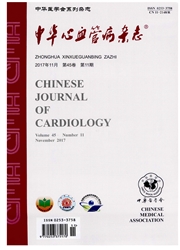

 中文摘要:
中文摘要:
目的探讨G蛋白激酶(GRK)4γ变异体A142V转基因小鼠血压升高的原因,以期了解GRK4γ在调控血压中的作用.方法以GRK4γA142V转基因小鼠为研究对象,分别对其血压、肾脏尿钠排泄功能、D1多巴胺受体的表达进行测定;并应用GRK4反义核苷酸技术处理HK-2细胞,研究在GRK4表达受到抑制的情况下D1受体的表达变化.结果与对照小鼠相比,GRK4γA142V转基因小鼠血压明显增高,肾脏D1受体介导的利尿、利钠作用明显下降,伴有肾脏皮质膜D1受体表达降低(0.6±0.2比1.5±0.2,n=3)、磷酸化程度增高[(65±7)DU比(35±7)DU,n=3];反义核苷酸抑制GRK4(1.2±0.1比1.3±0.1比0.6±0.1,n=6)表达后,D1受体的表达量增高(0.7±0.1比0.8±0.1比1.5±0.2,n=6),说明D1受体功能下降是GRK4γA142V转基因小鼠血压升高的原因.结论GRK4γ与高血压的发生关系密切,GRK4γA142V转基因小鼠血压升高与肾脏D1受体功能下降有关.
 英文摘要:
英文摘要:
Objective Abnormalities in dopamine production and receptor function have been described in human essential hypertension and rodent models of genetic hypertension. We investigated the role of G protein kinase (GRK) 4γ in essential hypertension in GRK4γ mutant A142V transgenic mice. Methods Blood pressure, renal sodium excretion, D1 receptor protein expression and phosphorylation were measured in GRK4γA142V transgenic mice and control mice. Moreover, the effects of GRK4 inhibition by antisense oligonucleotides on D1 receptor expressions were determined in HK-2 cells. Results As compared with their control mice, GRK4γA142V transgenic mice had higher blood pressure, lower D1 receptor expression (0. 6 +0. 2 vs. 1. 5 ±0. 2, P 〈0. 05), higher D1 receptor phosphorylation [ (65 ± 7) DU vs. (35 ± 7) DU, P 〈 0.05 ] in renal cortical membranes and the diuretic and natriuretic effects after stimulation of renal D1 receptor were impaired in GRK4γA142V transgenic mice. Inhibition of GRK4 expression (0. 60±0. 10 vs. 1.30± 0. 09, P 〈 0.05 ) by GRK4 antisense oligonucleotides upregulated D1 receptor expression ( 1.5 ± 0. 2 vs. 0. 8 ± 0. 1, P 〈 0. 05 ) in HK-2 cells. Conclnsions Our results show that GRK4γA142V overexpression induced hypertension is mediated by dowregulated renal D1 receptor expressions in GRK4γA142V transgenic mice.
 同期刊论文项目
同期刊论文项目
 同项目期刊论文
同项目期刊论文
 期刊信息
期刊信息
